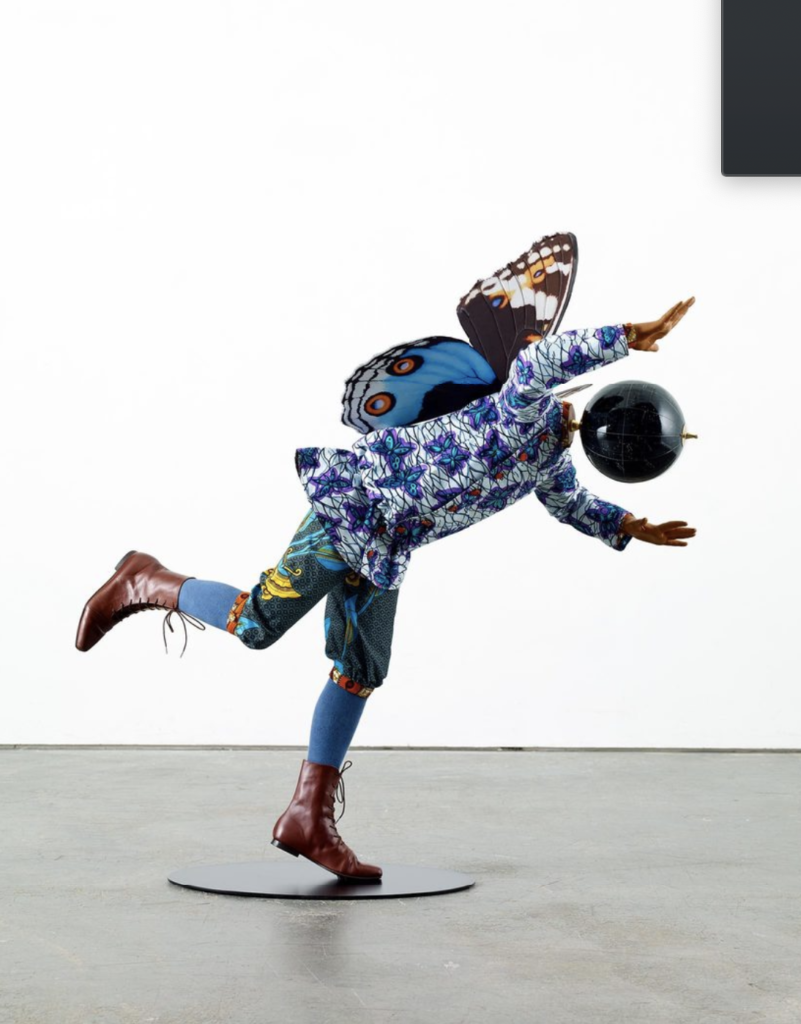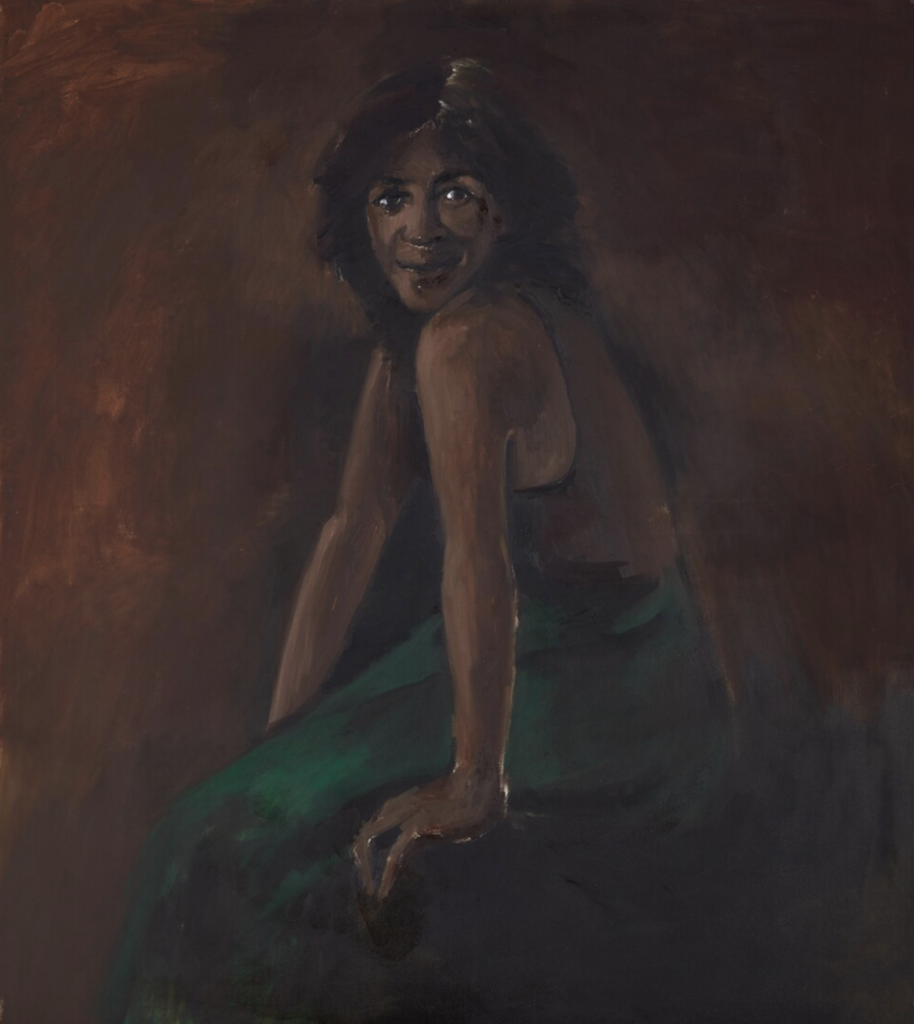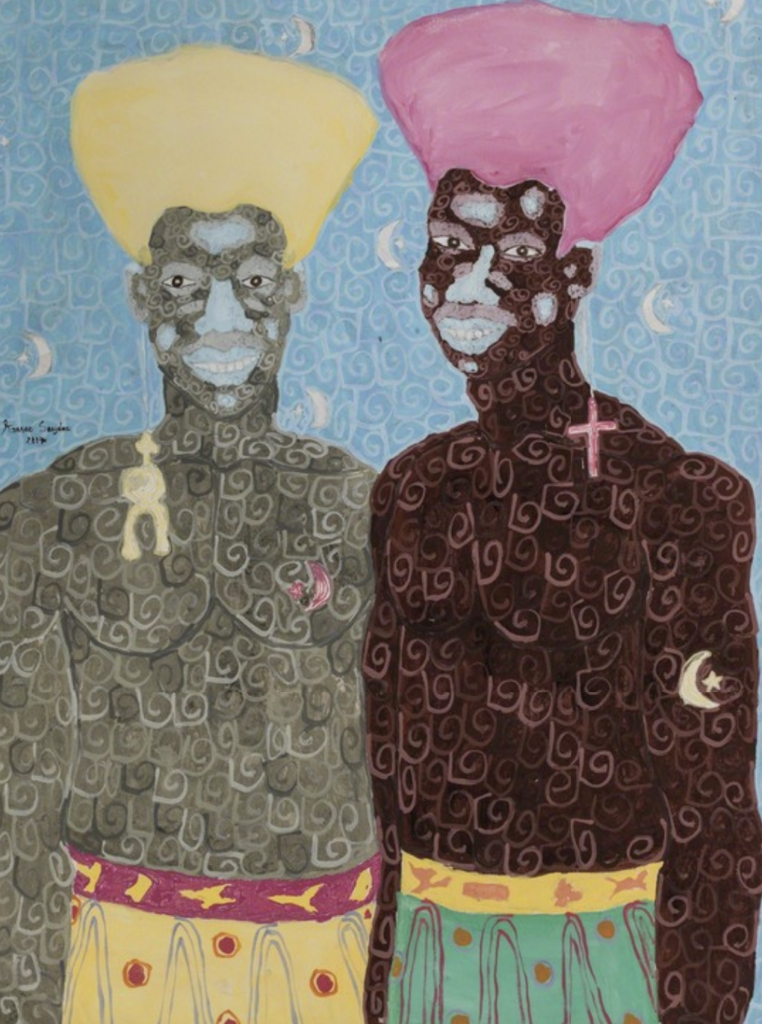It’s pride month!!! Even though in this beautiful land of African, citizens are not as accepting as in other Westernized countries. Africa has tried as much to be inclusive as far as LGBTQIA rights are concerned. Artists continue to challenge our perceptions of both male and female black figures. From placing male subjects in unconventional spaces meant for female figures to portraying female subjects in a strong masculine way. These artists explore the complexities and fluidity of the male and female identities. In this article, we will delve into the works of the artists.
Yinka Shonibare
Yinka Shonibare is one special artist, who invaded post-colonial British spaces with African fabrics. His vibrant sculptures examine the effects of globalization and colonization. His work often features headless figures, evoking a sense of anonymity and universality. Shonibare challenges traditional notions of gender and sexuality by incorporating queer subjects into his narratives, inviting viewers to question societal norms.

125 × 120 × 73.5 cm. Image courtesy of Artsy
In his artwork, ‘Justice for All’, he reconfigures Lady Justice, adorning her in brightly colored Dutch wax batik instead of the usual golden garb. A hand-painted globe replaces her head, symbolizing a universal identity. Shonibare’s work challenges traditional representations and explores the complexities of identity. His art reflects on the intersection between African and European cultures, highlighting the impact of colonialism. Through his creative expressions, Shonibare sparks conversations about power dynamics and the quest for freedom in the different identities present today.
Onyis Martin
Onyis Martin is a Kenyan contemporary artist, who explores themes of masculinity through his paintings. Growing up in Kisumu, he often faced strict and stringent rules surrounding male and female roles. He was not allowed to go into the kitchen, dress up in certain colors, etc. His medium of choice, Watercolor provides a certain fluidity to his works. It is so unconventional for men to wear laces, and bold bright patterns, in his work, his subjects are often placed behind the lace or even in line with the bold patterns.

In a subtle way, his art shows him breaking free from the norm that he grew up seeing in Kisumu after he came to the bustling city. Nairobi is a diverse city accommodating all kinds of people and in some way, this has come to be him. Martin’s work seeks to redefine masculinity and challenge the limited representations of black queer individuals in mainstream media, promoting a more inclusive and diverse narrative.
Toyin Ojih Odutola
In her series, “A Countervailing Theory,” Toyin Ojih Odutola immerses us in an imaginary pre-historic civilization where muscular warrior women rule and naked male humanoids serve. The drawings challenge conventional expectations of gender, race, and sexuality, with inverted societal norms. Her monochrome scenarios draw influences from cinematic storyboarding and graphic novels, executed with virtuoso technique. Subservient men toil while females exhibit confidence, cradling their weapons. Worker males lack genitals and are forbidden from emotional and sexual relationships with females. Same-sex couplings are the only permitted relationships. The drawings portray a forbidden love affair between a worker and a warrior, ending with the lovers ossified into rock formations. Walk through the exhibition here

The exhibition offers porous nuanced propositions, open to interpretation. It depicts a queer, Black, female-dominated society that challenges historical hierarchies, yet is also brutally oppressive, with a dictatorial ruling class. This is a true example of artistry to challenge the norms as it speaks of an origin story that is beside what we have come to see and know as Africans.
Lynette Yiadom-Boakye
Lynette Yiadom-Boakye, a British-Ghanaian artist, creates powerful portraits that blur the boundaries of gender and sexuality. Her paintings often feature ambiguous figures, both male and female, challenging viewers to question preconceived notions of identity. The enigmatic portraits feature Black figures in evocative settings, sourced from magazines or her imagination. Her subjects are a blend of reality and imagination, prompting viewers to interpret and contemplate questions of identity and representation. Created from found images and her own imagination, these figures exist beyond time and place.

Image courtesy of Artsy
She uses poetic titles like “Tie the Temptress to the Trojan 2016” to capture her spontaneous bursts of creativity. Poetry is very significant to her artistic process as it allows her to express what cannot be painted and paint what cannot be written. Yiadom-Boakye’s work celebrates the fluidity of human expression, embracing the multiplicity of human identities. With minimalist clothing and moody backdrops, she emphasizes their inner lives. Her intuitive compositions highlight the material properties of her paints and brushstrokes. This is precisely the reason why Tate Modern describes her exhibitions as glimpses into a fantastical community.
Kassou Seydou
Kassou Seydo, a Senegalese artist, employs mixed media techniques to represent the Male and female experience in Africa. His artwork incorporates elements of traditional African culture with contemporary influences, highlighting the intersectionality of these identities. Seydo’s work celebrates the resilience and strength of African communities showcasing the beauty that exists within diverse sexual orientations and gender expressions.

Image courtesy of Artsy.
His large-scale figurative paintings depict a harmonious society where humans coexist with nature. His artwork showcases human figures in different shades, engaged in work and leisure, amidst swirling patterns. The paintings create a mesmerizing and hypnotic effect. Through constant circular shapes, he creates a disordered world that showcases the complexity of human existence. Using warm colors and lively characters, the Senegalese painter presents his unique perspective on the world. He invites viewers to engage in conversations about identity, sexuality, and the need for equality.
These artists exemplify the growing movement within African art to challenge societal norms and promote inclusivity. Through their work, they celebrate the rights of queer individuals, pushing for greater acceptance and understanding within African society.
As we celebrate pride month, let us appreciate and support these African queer and black artists as they use their creativity to promote social change. Their works serve as a reminder that queer rights are human rights. Additionally, they are also a reminder that diversity should be embraced in all its forms. Through art, we can continue to challenge stereotypes and break down barriers. Moreover, we can create a more inclusive and accepting society for everyone.


